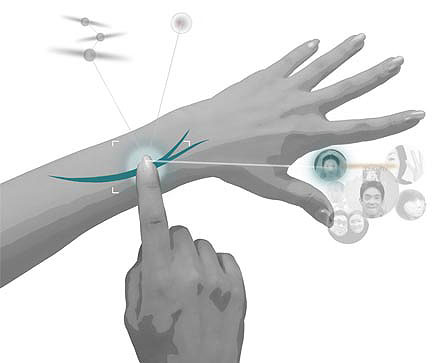Twenty-five years after the creation of the cell phone, designers at Motorola imagined what cell phones might look like in another twenty five years. The Consumer Xperience Design (CXD) team created a portfolio of sketches that look beyond what is possible today and imagine the possibilities of the future.



Similar to a scrapbook, the MEM, also from UK engineers, saves experiences and allows users to share memories with others throughout life. As more memories are made and stored, intricate patterns begin to form on the outside surface, a metaphor for the creation of our brain’s neural networks.




A design submission from the UK uses holographic projection and gesture detection with an added virtual layer of information and avatars. Second Sight lets users see the world in a whole new way through touch screens and holographic displays to make the communications experience more interactive.

Seoul engineers envision a gel-type phone that adheres to skin, with the display worn around the eye area and an interface worn on the arm. These adhesive devices work as a connector and sensor with interaction between the two allowing for communication and expression of personal style.
In 2033, the “cell phone” could be an extension of our bodies and senses, where information could be exchanged and communication could be achieved through universal gestures. Moreover, embedded technology could become more accepted, designs could be more varied and shape-shifting technologies could enable people to adapt devices for different needs.
In 2033, the “cell phone” could be an extension of our bodies and senses, where information could be exchanged and communication could be achieved through universal gestures. Moreover, embedded technology could become more accepted, designs could be more varied and shape-shifting technologies could enable people to adapt devices for different needs.

Similar to a scrapbook, the MEM, also from UK engineers, saves experiences and allows users to share memories with others throughout life. As more memories are made and stored, intricate patterns begin to form on the outside surface, a metaphor for the creation of our brain’s neural networks.

North American engineers also came up with a slick, wearable device with holographic images that follows a user’s hand to signal incoming calls and messages. Users simply turn their palm upward to receive messages, flip their wrist outward to send and bring their hand to their ear to take a private call.
By 2033:
— Communication could be ambient, always on, and people could live online
— Computers and mobile devices could be embedded in the ordinary
— “Using Software” could vanish; only interface and human interaction would remain
— Device interaction could become natural, predictive, and fluid
— Mollecular manufacturing could revolutionize production
— Objects could access ‘The Cloud’ at will
By 2033:
— Communication could be ambient, always on, and people could live online
— Computers and mobile devices could be embedded in the ordinary
— “Using Software” could vanish; only interface and human interaction would remain
— Device interaction could become natural, predictive, and fluid
— Mollecular manufacturing could revolutionize production
— Objects could access ‘The Cloud’ at will


By opening the transponder cap, the display mode of this design from Latin American engineers activates and allows users to define the display in any shape and size. The touch screen, set in motion by oxygen-activated liquid crystals, appears once the cap is taken off. To end connectivity close the cap and the display will dissolve.
The CXD teams from around the globe, including China, Korea, North America, Latin America and the UK sketched their visions of what cell phones could look and function like in 2033. Based on both technological advances and regional preferences, the design teams created sketches tailored to each region’s unique priorities and tastes.
The CXD teams from around the globe, including China, Korea, North America, Latin America and the UK sketched their visions of what cell phones could look and function like in 2033. Based on both technological advances and regional preferences, the design teams created sketches tailored to each region’s unique priorities and tastes.







0 comments:
Post a Comment